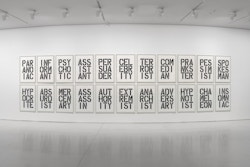Bertrand Lavier, Frank Walter and Christopher Wool in Le monde comme il va
20 March—2 September 2024
Group Exhibition at Bourse de commerce, Paris, France
In the spring of 2024, a set of iconic works from the Pinault Collection will be displayed throughout the Bourse de Commerce. Like a dizzying spiral within which images are generated, talk to one another, and telescope each other, they highlight François Pinault’s passion for, and commitment to, contemporary art.
Bringing together works mainly from the 1980s to the present day, the exhibition reveals the heightened awareness of the present that artists express. Le monde comme il va (The World As It Goes in english) alludes to the tumult and turbulence of current events. Stable reference points everywhere seem to be faltering and slipping away. The title comes from a philosophical tale by Voltaire in which an angel sends an envoy to observe the behaviours of a faraway people, as the Gods no longer know whether they deserve to live or should be destroyed to make way for a newer and better civilisation. Confronted with the paradoxes of humanity and his own hesitation, the narrator ultimately decides to let “the world go as it goes”, trusting that humans will take their destiny into their own hands. The works from the Pinault Collection selected for this show bear witness to this moment of uncertainty, but they also serve to draw visitors into the momentum of this sphere which keeps on turning regardless, and in the sway of whose movements we collectively write our history.
This awareness of artists is demonstrated by Kimsooja’s monumental yet delicate piece installed in the Museum Rotunda, in the context of a "carte blanche" given to the artist. An immense mirror placed on the ground inverts the architecture and with it, the order of the world. As we approach, we see the sky falling into the ground beneath our feet at the centre of the Bourse de Commerce.
The invisibility of the material, which merely reflects its surrounding reality, reminds us that we are the protagonists of this narrative. An “overview” emerges on the first floor: Fischli & Weiss are exhibiting a part of their vast undertaking that involves a clay modelling of a (necessarily partial) history of humanity (Suddenly this Overview, 1981-2012). In the ground floor galleries and on the second floor, the selection of works from the Pinault Collection show how contemporary artists, working both in the wake of the avant-garde and the spirit of their own time, often employ strategies of provocation, subversion, and infiltration to work against traditional values and to cast a general veil of doubt over our definitions of art. Works by Maurizio Cattelan, Damien Hirst and Jeff Koons, early icons in the Pinault Collection, reveal their complexity once they are re-situated in a context of circulating images, objects and values that marks the history of art in the 1980s and 1990s. They also attack the underlying mechanisms of various power structures – political, institutional, or otherwise – and formulate a more bitter commentary than it may seem regarding the society in which these works have been produced.
The ghosts of the past appear to rise up as a warning in the works of Maurizio Cattelan, Cindy Sherman, Luc Tuymans and Sun Yuan & Peng Yu. Works by Anne Imhof, Doris Salcedo, Wolfgang Tillmans, Rosemarie Trockel, Christopher Wool, and others react to the utopias in crisis in our contemporary world, staging them and forming receptacles for a silent fury that art expresses and transfigures. “Huis clos” paintings, conflagrations, domestic reversals, double images, portraits of a vacillating identity, reinterpretations and reprises form the subject of works by Peter Doig, Marlene Dumas, Martin Kippenberger, Sturtevant, Frank Walter, and Franz West.
François Pinault’s choices as a collector have always reflected his passion for an art that exists in sync with its time, be it socially committed or simply observing, provocative or darker. Faced with the excesses and paradoxes of our society and our world, as well as the difficulties of our time, the artists are at times prophetic and visionary, at others philosophical. Sometimes they are cynical and ironic, often they are poetic and re-enchanting. It is the flow of images taken in by the world’s motions, their ability to reflect reality or, to the contrary, to create a mise en abyme around it, to resonate in empathy or irony with the past and present that have nourished the Pinault Collection for the last fifty years.


